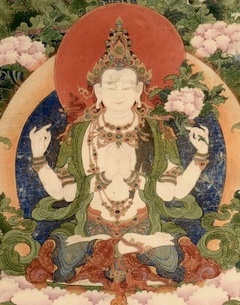Avalokiteśvara Series
Deities › Avalokiteśvara
English (31) | Deutsch (5) | Español (5) | Français (10) | Português (1) | བོད་ཡིག (31)

Four-Armed Avalokiteśvara
Courtesy of Himalayan Art Resources
Further information:
Your thousand arms are the thousand universal monarchs,
Your thousand eyes the thousand buddhas of this fortunate age,
You who teach each and every one of us according to our needs,
Lord Avalokiteśvara, to you I pay homage!
A series of texts related to the bodhisattva of compassion, Avalokiteśvara (spyan ras gzigs):
Aspiration Prayers
Dukngal Rangdrol
- The Refined Essence of Compassion: A Daily Sādhana for the Natural Liberation of Suffering, the Secret Practice of the Great Compassionate One by Dilgo Khyentse Rinpoche
- A Splendid Profusion of Merit: A Feast-Offering for the Secret Practice of the Great Compassionate One, Natural Liberation of Suffering from The Heart-Essence of the Vast Expanse by Dodrupchen Jigme Trinle Özer
- The Excellent Path to Perfect Liberation: A Guidance Practice (Nedren) for the Dukngal Rangdrol (Natural Liberation of Suffering) Practice of the Great Compassionate One from the Longchen Nyingtik by Dodrupchen Jigme Trinle Özer
- The Spontaneous Fulfilment of All Wishes: Confession and Fulfilment for the Great Compassionate One, Natural Liberation of Suffering by Dodrupchen Jigme Trinle Özer
- The Visualization of the Four Goddesses of the Great Compassionate One, Natural Liberation of Suffering by Jamyang Khyentse Wangpo
- Clarifying the Self-Initiation: An Empowerment of the Great Compassionate One, the Natural Liberation of Suffering by Jigme Lingpa
- The Loud Drum of Summer: A Commentary on the Difficult Points of the Ritual of the Great Compassionate One, Natural Liberation of Suffering by Jigme Lingpa
Guru Yoga
Mantra
Practices
Praise
Prayers
A simple two-verse prayer to Avalokiteśvara written at the request of a disciple from Washul, Amdo.
Sādhanas
- The Method of Accomplishment of Ārya Avalokiteśvara: The Practice of Great Compassion & Mahāmudrā in Union by Chögyal Pakpa Lodrö Gyaltsen
- The Essence of Cintāmaṇi: A Daily Practice of the Great Compassionate One, Wish-fulfilling Wheel by Jamyang Khyentse Wangpo
- The Method of Accomplishment of Ārya Avalokiteśvara: The Practice of Great Compassion & Mahāmudrā in Union by Ngorchen Könchok Lhundrup
- The Sādhana of the Five Self-Arisen Noble Brothers: An Instruction in the Union of Generation and Completion by Shikpo Lingpa